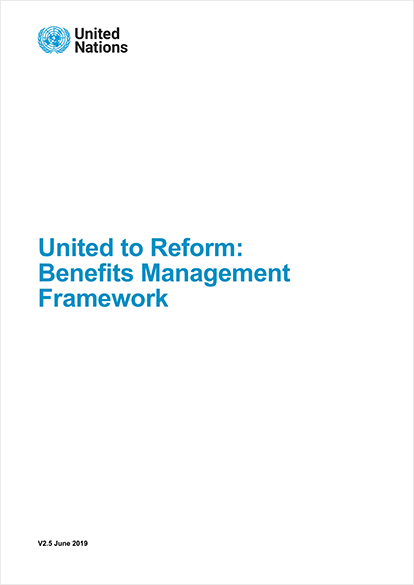Benefits Framework
Benefits framework
 The benefits framework is the first UN-wide approach to managing change. It creates a common understanding on how to clearly identify and define the objectives of any change, implement, monitor and report on them.
The benefits framework is the first UN-wide approach to managing change. It creates a common understanding on how to clearly identify and define the objectives of any change, implement, monitor and report on them.
Benefits are
the measurable improvement resulting from an outcome perceived as an advantage by one or more stakeholders, which contributes towards one or more organisational objectives
The benefits of our reforms may not be financial or even quantifiable, but this does not mean they are not real improvements.
“The framework is intended to help us know we are delivering the reforms we promised; (a) improving our ability to deliver mandates more effectively, and (b) demonstrating the UN is a more transparent, accountable, agile and flexible organisation. Furthermore, the framework is the stepping stone for the UN to transition to a continuous improvement system.
Benefits management is not a ‘tick box exercise’. UN staff need to apply critical thinking and professional judgement, supported, but not constrained by, the approaches and tools detailed in this framework. This framework is principles based and reflects lessons learned from our collective experience to date, the results of a recent pilot, and good practice from other organisations around the world. The framework is a live document and will be continuously improved based on our experiences.
There is an expression; “every improvement is a change, but not every change is an improvement”. It is our responsibility to help the Secretary-General demonstrate to the UN’s stakeholders that the UN is not only changing but improving. Proving the benefits throughout the reform process and beyond will help us achieve this."
—Jens Wandel
Download the benefits framework
If you have any questions please email eosgbenefitsmanagement@un.org for more information.
Benefits categories
In the section below, you can learn about the different benefits categories and their definitions by hovering over them.
-
Increased transparency
Transparency over resources and results at the level of organizations as well as at the level of individual managers -
Cross-pillar cooperation
Stronger cross-pillar cooperation with Development and Human Rights pillars -
Whole-of-pillar approach
Reduced fragmentation of efforts and a more joined up, whole-of-pillar approach for Peace and Security -
Organizational functions
Better results through alignment of structures with the 2030 Agenda for Development and Sustaining Peace at the country, regional and global levels -
Gender parity
Transforming institutional culture through achievement of gender parity
-
Simplification
Streamlining of processes to make them more cost effective and efficient -
Capability
Enhanced capabilities to deliver on mandates and the Agenda 2030 -
Coherence / coordination
A joined up, coordinated and integrated approach to delivery of results -
Effectiveness
Substantive performance of an organization -
Efficiency
The most economical use of resources with a unique contribution to improving concrete aspects of operations
-
Empower managers
Increased manager’s ability to determine how best to use resources to support programme delivery and mandate implementation -
Delegation
Enhancing and accelerating responses to requirements on the ground through increased delegation -
Accountability
Greater accountability for managing resources and delivering results at an organizational and individual level -
Alignment
Strong alignment of responsibility, resources and accountability -

